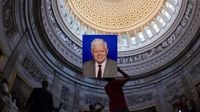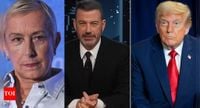For millions of Americans, late-night television is more than just a way to unwind—it’s a cultural institution, a place where the nation’s pulse is measured in jokes and monologues. But in September 2025, the familiar rhythms of late-night TV were upended when "Jimmy Kimmel Live!" was abruptly pulled from ABC stations across the country, sparking a firestorm that reached far beyond the world of entertainment.
The controversy began on September 17, when ABC suspended Jimmy Kimmel after he made remarks about the death of conservative activist Charlie Kirk. The backlash was swift and fierce, with former President Donald Trump and several conservative groups demanding Kimmel’s punishment. According to Reuters, the suspension triggered a wave of criticism from all corners—Hollywood stars, free speech advocates, and everyday viewers decried ABC’s move as censorship. The Writers Guild of America (WGA) condemned what it called “corporate cowardice,” even staging a protest outside Disney headquarters (Waging Nonviolence).
Media conglomerates Sinclair and Nexstar soon joined the fray, pulling "Jimmy Kimmel Live!" from their ABC affiliates. For six days, the late-night staple vanished from screens, leaving fans and critics alike to wonder what would come next. But as it turned out, the suspension was just the opening act in a much larger drama about media freedom, corporate power, and the ever-present tug-of-war between politics and the press.
When "Jimmy Kimmel Live!" returned to air on September 23, the response was nothing short of historic. The comeback episode drew more than 6.2 million viewers on ABC—the show’s highest ratings in a decade—and over 26 million people watched Kimmel’s monologue online (Reuters). During his return, Kimmel didn’t shy away from the controversy, quipping, “We couldn’t have done it without you, Mr. President.” Tennis legend Martina Navratilova, a longtime advocate for free speech and media independence, voiced her support on X (formerly Twitter), writing simply, “lol. And true.”
Navratilova’s involvement didn’t end there. She warned her followers that the events unfolding looked like the “DICTATOR PLAYBOOK,” and agreed with posts calling America a fascist state. Her words echoed a growing sense of unease among those who saw the suspension as more than just a corporate decision—it was, in their view, a troubling sign of government influence over media. “It was never my intention to make light of the murder of a young man,” Kimmel later clarified (CBS News), but the damage—and the debate—was already done.
Behind the scenes, the pressure on Disney and ABC was mounting. As Waging Nonviolence reported, the Federal Communications Commission (FCC) had been leveraging a merger approval to exert executive branch control over the media. This wasn’t just about one late-night host; it was part of a broader push to consolidate power across various pillars of society, including the media, security forces, bureaucracy, and business leaders. The article described the suspension as a “stress test” for American democracy, warning that the next attempt at censorship might not target a high-profile host, but instead come in the form of quiet cancellations or subtle self-censorship throughout the industry.
Public backlash proved decisive. Disney talent began calling for a boycott, and Google searches for “cancel Disney+” surged. The WGA’s protest outside Disney headquarters signaled that both workers and consumers were willing to take action. According to Waging Nonviolence, the reversal of Kimmel’s suspension was not an act of corporate conscience but a “strategic retreat” in the face of coordinated pressure. The episode highlighted a truth often overlooked: media conglomerates, for all their power, are ultimately accountable to the people who watch, create, and support their content.
Yet the story didn’t end with Kimmel’s return. Dozens of ABC affiliates owned by Nexstar and Sinclair continued to refuse to air his show, prolonging the debate over who controls the nation’s airwaves. A new advocacy group, I Have Friends Everywhere, emerged to shift boycott energy toward these companies and pressure their advertisers to cut ties until the censorship ended. The moment had become a rallying point for those concerned about the fragility of media freedom in the face of both governmental and corporate power.
Meanwhile, the controversy cast a spotlight on Nexstar Media Group, one of the largest owners of local television stations in the United States. For investors, the timing was striking. Nexstar’s stock had experienced a 5.3% decline over the past week and a 3.3% drop in the past month, yet its year-to-date returns remained strong at 24.2%, with a remarkable 156.0% return over the past five years (Simply Wall St). Despite the recent turbulence, analysts noted that the company’s fundamentals were robust. Nexstar’s Free Cash Flow stood at $1.23 billion, with projections of approximately $1.10 billion by 2028. A discounted cash flow analysis estimated the company’s intrinsic value per share at $646.91, suggesting the stock was trading at a substantial 69.4% discount—an indication of significant undervaluation.
Other valuation metrics told a similar story. Nexstar’s Price-to-Earnings (PE) ratio was 9.9x, far below the industry average of 20.4x and even under the peer average of 10.9x. Simply Wall St’s proprietary Fair Ratio for Nexstar was 18.7x, further supporting the notion that the market was undervaluing the company relative to its earnings outlook and risk profile. The numbers seemed to suggest opportunity, but also underscored the risks of operating in a volatile media landscape where political and corporate interests can collide without warning.
The Kimmel controversy became a case study in how quickly the ground can shift beneath both media companies and their investors. Some saw the episode as a warning about the dangers of executive overreach and regulatory leverage, particularly when the FCC’s approval of mergers can be used as a tool for political influence. Others viewed the public’s response—the boycotts, protests, and massive viewership for Kimmel’s return—as proof that ordinary people still have the power to hold corporations and governments accountable.
For now, "Jimmy Kimmel Live!" is back on the air, and Nexstar’s future remains a subject of debate among investors and media watchers alike. The episode has left a lasting mark on the ongoing conversation about free speech, corporate responsibility, and the delicate balance of power in American media. Whether this moment serves as a turning point or just another flashpoint remains to be seen, but one thing is clear: the battle over who controls the nation’s narrative is far from over.



